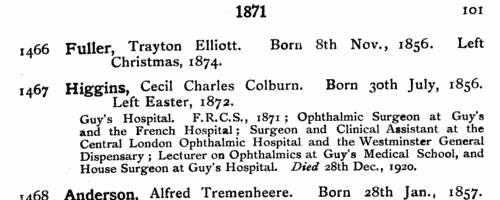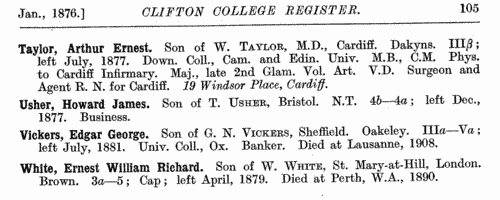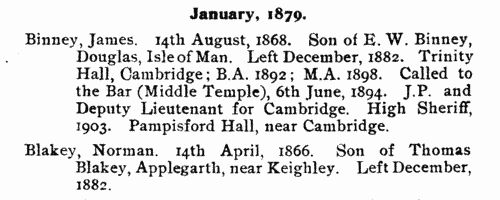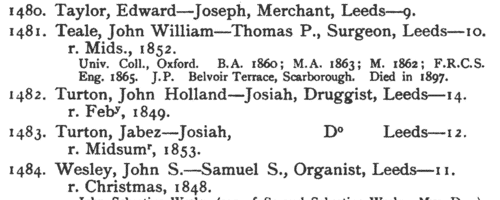Add this eBook to your basket to receive access to all 5,602 records. Our indexes include entries for the spelling hall. In the period you have requested, we have the following 5,602 records (displaying 4,191 to 4,200): These sample scans are from the original record. You will get scans of the full pages or articles where the surname you searched for has been found. Your web browser may prevent the sample windows from opening; in this case please change your browser settings to allow pop-up windows from this site. Freeholders in the city of Limerick
(1873-1875)
Owners of an acre or more, whether resident there or elsewhere: with their addresses; the acreage; and a valuation of the land. The survey commenced in February 1873, the last returns being received in November 1875. | Sample scan, click to enlarge

| Boys entering Brighton College
(1875)
This edition of the Brighton College Register was published in 1922. The plan of the publication was to list boys by year or, later, term of entry. Each name is assigned a sequential number, 5000 boys, in all, being recorded. Full name is given (surname first, in bold); year of birth; year of leaving; and then (wherever the compiler had such information) a short biography, ending with date of death, where known. | Sample scan, click to enlarge

| Boys entering Clifton College
(1875)
Clifton College near Bristol was established in 1862. This edition of the Clifton College Annals and Register for the Old Cliftonian Society by F. Borwick was published in 1925. Boys are listed alphabetically by term of entry, with full names, surname first, in bold. Father's (or widowed mother's) name is given (surname and initials) in capitals, and address. Then there is the name of the house (N. T., North Town; S. H., School House; S. T., South Town), first and last forms, distinctions in school work and games, and month of leaving. Where known, the editor then gave a career summary with month of death; or, if still living, address as in 1925 (in italics). | Sample scan, click to enlarge

| Boys entering Giggleswick School
(1875)
The school at Giggleswick in the West Riding of Yorkshire dates from at least 1507, but no register of the boys attending there has survived earlier than one started by the headmaster, the reverend George Style, in 1875. When the bursar, H. L. Mullins, prepared this, 'The Giggleswick School Register', printed in 1913, he was able to compile general details of some scholars from earlier years, but the concerted, reasonably complete, account starts in 1859. The details are arranged by term of entry, then alphabetically by surname and christian name. Typically each description gives full name; date of birth; name and address of father; date of leaving. Where known, Mullins then added a brief career synopsis, present address in 1913, or date of death. From 1869 onwards boarders were admitted to the school, and where it is known that a boy was a day scholar, the word (Town) is added after his name. | Sample scan, click to enlarge

| Boys entering Leeds Grammar School
(1875)
The admission books for Leeds Grammar School from 1820 to 1900 were edited by Edmund Wilson and published in 1906. The series of registers is almost complete for the period, there being in addition admission registers for the Lower (or Commercial) Department from 1856 to 1865, and lists of boys in the school in 1856, and in the Commercial Department in 1861. The entries are arranged by date or term of admission: a sequential number is given first, then surname, christian name, and, after a dash, father's christian name, occupation, and address; another dash, and then the age of the boy at admission, and often his year of leaving (with the abbreviation r. for 'removed' or 'left'). r.* means left without notice; (o) or S. or Stranger or Foreigner indicates a boy not on the foundation. The editor was unable to divine the meaning of the abbreviation (Q) or the asterisks prefixed to most entries in 1856 to 1860, but dutifully copies them into the text. In smaller type he then proceeds, where possible, to add some information about the boy's subsequent career. | Sample scan, click to enlarge

| Mining Fatalities: Gloucestershire, Herefordshire, &c.
(1875)
The fourteen Inspectors of Mines for the United Kingdom of Great Britain and Ireland made separate annual reports, each including a tabular account of fatal mining accidents within his area, giving date; sequential number of accident for the area for the year; the name of the mine; where situate; the owner's or agent's name; the full name of the person killed; his occupation; age; cause of death, and remarks. There are in all fifteen tables, for: Cornwall, Devon, Dorset and part of Somerset; Cumberland, Northumberland and Furness; Ireland; the Midlands; North and East Lancashire; North Staffordshire, Cheshire and most of Shropshire; North Wales (including an adjoining part of Shropshire) and the Isle of Man; Western Scotland; the rest of Scotland; South Durham, Westmorland and the North Riding of Yorkshire; Gloucestershire, Herefordshire, Wiltshire, Monmouthshire and adjoining parts of South Wales; South Staffordshire and Worcestershire (the Black Country); the rest of South Wales; western Lancashire; and Yorkshire (other than the North Riding) and Lincolnshire. | Sample scan, click to enlarge

| Mining Fatalities: North Staffordshire, Cheshire and Shropshire
(1875)
The fourteen Inspectors of Mines for the United Kingdom of Great Britain and Ireland made separate annual reports, each including a tabular account of fatal mining accidents within his area, giving date; sequential number of accident for the area for the year; the name of the mine; where situate; the owner's or agent's name; the full name of the person killed; his occupation; age; cause of death, and remarks. There are in all fifteen tables, for: Cornwall, Devon, Dorset and part of Somerset; Cumberland, Northumberland and Furness; Ireland; the Midlands; North and East Lancashire; North Staffordshire, Cheshire and most of Shropshire; North Wales (including an adjoining part of Shropshire) and the Isle of Man; Western Scotland; the rest of Scotland; South Durham, Westmorland and the North Riding of Yorkshire; Gloucestershire, Herefordshire, Wiltshire, Monmouthshire and adjoining parts of South Wales; South Staffordshire and Worcestershire (the Black Country); the rest of South Wales; western Lancashire; and Yorkshire (other than the North Riding) and Lincolnshire. | Sample scan, click to enlarge

| Mining Fatalities: South Durham, Westmorland and the North Riding
(1875)
The fourteen Inspectors of Mines for the United Kingdom of Great Britain and Ireland made separate annual reports, each including a tabular account of fatal mining accidents within his area, giving date; sequential number of accident for the area for the year; the name of the mine; where situate; the owner's or agent's name; the full name of the person killed; his occupation; age; cause of death, and remarks. There are in all fifteen tables, for: Cornwall, Devon, Dorset and part of Somerset; Cumberland, Northumberland and Furness; Ireland; the Midlands; North and East Lancashire; North Staffordshire, Cheshire and most of Shropshire; North Wales (including an adjoining part of Shropshire) and the Isle of Man; Western Scotland; the rest of Scotland; South Durham, Westmorland and the North Riding of Yorkshire; Gloucestershire, Herefordshire, Wiltshire, Monmouthshire and adjoining parts of South Wales; South Staffordshire and Worcestershire (the Black Country); the rest of South Wales; western Lancashire; and Yorkshire (other than the North Riding) and Lincolnshire. | Sample scan, click to enlarge

| Mining Fatalities: Southern Yorkshire and Lincolnshire
(1875)
The fourteen Inspectors of Mines for the United Kingdom of Great Britain and Ireland made separate annual reports, each including a tabular account of fatal mining accidents within his area, giving date; sequential number of accident for the area for the year; the name of the mine; where situate; the owner's or agent's name; the full name of the person killed; his occupation; age; cause of death, and remarks. There are in all fifteen tables, for: Cornwall, Devon, Dorset and part of Somerset; Cumberland, Northumberland and Furness; Ireland; the Midlands; North and East Lancashire; North Staffordshire, Cheshire and most of Shropshire; North Wales (including an adjoining part of Shropshire) and the Isle of Man; Western Scotland; the rest of Scotland; South Durham, Westmorland and the North Riding of Yorkshire; Gloucestershire, Herefordshire, Wiltshire, Monmouthshire and adjoining parts of South Wales; South Staffordshire and Worcestershire (the Black Country); the rest of South Wales; western Lancashire; and Yorkshire (other than the North Riding) and Lincolnshire. | Sample scan, click to enlarge

| Mining Fatalities: The Midlands
(1875)
The fourteen Inspectors of Mines for the United Kingdom of Great Britain and Ireland made separate annual reports, each including a tabular account of fatal mining accidents within his area, giving date; sequential number of accident for the area for the year; the name of the mine; where situate; the owner's or agent's name; the full name of the person killed; his occupation; age; cause of death, and remarks. There are in all fifteen tables, for: Cornwall, Devon, Dorset and part of Somerset; Cumberland, Northumberland and Furness; Ireland; the Midlands; North and East Lancashire; North Staffordshire, Cheshire and most of Shropshire; North Wales (including an adjoining part of Shropshire) and the Isle of Man; Western Scotland; the rest of Scotland; South Durham, Westmorland and the North Riding of Yorkshire; Gloucestershire, Herefordshire, Wiltshire, Monmouthshire and adjoining parts of South Wales; South Staffordshire and Worcestershire (the Black Country); the rest of South Wales; western Lancashire; and Yorkshire (other than the North Riding) and Lincolnshire. | Sample scan, click to enlarge

|
Research your ancestry, family history, genealogy and one-name study by direct access to original records and archives indexed by surname.
|











